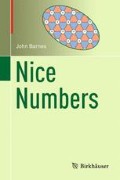Abstract
WE BRIEFLY met Pascal’s triangle in the lecture on Probability when we saw how it arose through the ways of getting different numbers of heads and tails when tossing several coins. We also noted that it could be introduced as the coefficients in the binomial expansion of (x + y)n.
Access this chapter
Tax calculation will be finalised at checkout
Purchases are for personal use only
Preview
Unable to display preview. Download preview PDF.
Author information
Authors and Affiliations
Corresponding author
Rights and permissions
Copyright information
© 2016 Springer International Publishing Switzerland
About this chapter
Cite this chapter
Barnes, J. (2016). Pascal’s Triangle. In: Nice Numbers. Birkhäuser, Cham. https://doi.org/10.1007/978-3-319-46831-0_12
Download citation
DOI: https://doi.org/10.1007/978-3-319-46831-0_12
Published:
Publisher Name: Birkhäuser, Cham
Print ISBN: 978-3-319-46830-3
Online ISBN: 978-3-319-46831-0
eBook Packages: Mathematics and StatisticsMathematics and Statistics (R0)

